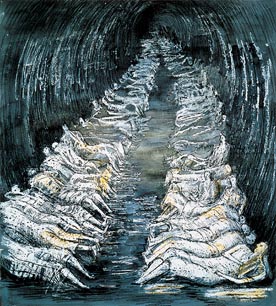One evening in the autumn of 1940, Henry Moore was travelling home to his studio in Hampstead by tube, when he found himself trapped at Belsize Park, one of the deepest stations on the Northern Line. The Blitz had just begun and the sculptor found himself among hundreds of people sheltering from an air-raid. He was fascinated by the sight of a multitude of huddled bodies, in the half-dark, far underground – partly for its sheer pathos and humanity, but also because it struck him immediately as a curious case of life imitating art. Moore’s own sculpture had become increasingly dominated by reclining figures, which now seemed uncannily mirrored in the spectacle before him:
“I was fascinated by the sight of the people camping out deep under the ground. I had never seen so many rows of reclining figures and even the holes out of which the trains were coming seemed to me to be like the holes in my sculpture. And there were intimate little touches. Children fast asleep, with trains roaring past only a couple of yards away. People who were obviously strangers to one another forming tight little intimate groups. They were cut off from what was above, but they were aware of it. There was tension in the air. They were a bit like the chorus in a Greek drama telling us about the violence we don’t actually witness.”
Moore made a couple of sketches of the scene, which he subsequently showed to Kenneth Clark, then chairman of the War Artists’ Advisory Committee. Clark, who was one of Moore’s closest friends and patrons, was sufficiently impressed to commission an entire series of works on the same theme. For much of the next two years, Moore concentrated on the creation of his so-called “shelter drawings”....


